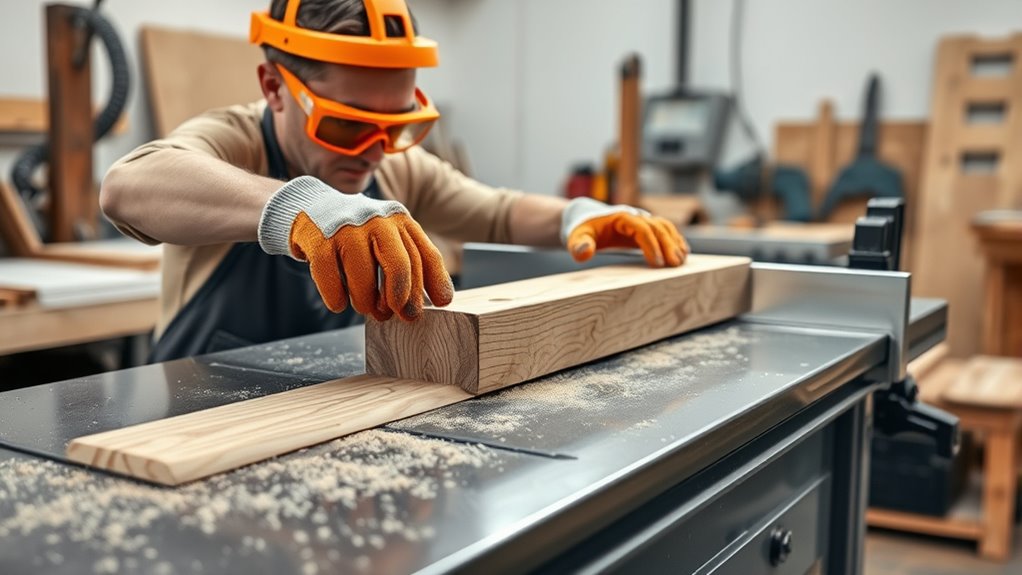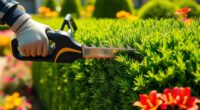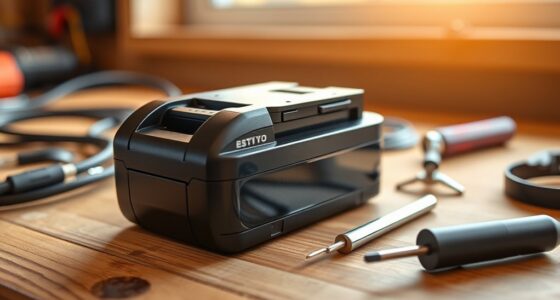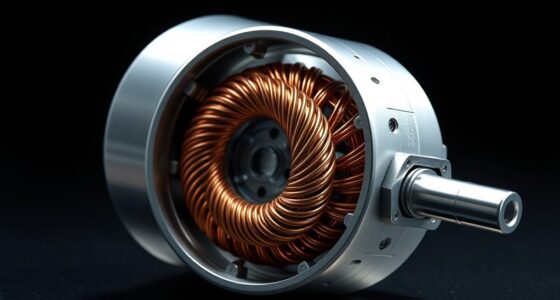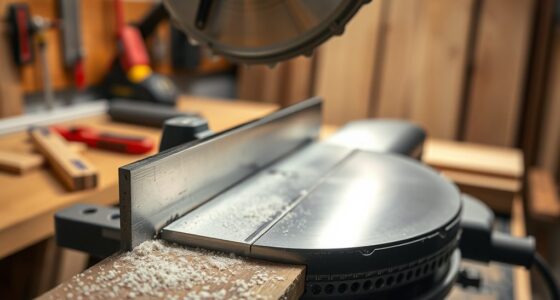To use a table saw safely, always familiarize yourself with its safety features, especially the blade guard, and guarantee it moves freely and is properly aligned. Use push sticks for narrow pieces and support large boards with rollers or stands. Focus on steady, controlled pushes, and never reach across the blade. Turn off and unplug the saw before adjustments or cleaning. Following these steps helps prevent accidents—continue here to learn more safety tips.
Key Takeaways
- Always wear appropriate safety gear and ensure the blade guard moves freely and is properly aligned before use.
- Keep hands behind push sticks and avoid reaching near the blade during operation.
- Support large or long workpieces with rollers or stands to prevent wobbling and maintain control.
- Turn off and unplug the saw before making adjustments or clearing debris to prevent accidental startup.
- Make steady, controlled cuts, and wait for the blade to fully stop before repositioning or removing workpieces.

Using a table saw can be a powerful and efficient way to complete woodworking projects, but safety must always come first. Before you even plug in the saw, take a moment to familiarize yourself with its safety features, especially the blade guard. The blade guard covers the saw blade, preventing accidental contact and helping keep your hands away from the cutting edge. Never remove or bypass the blade guard, as it’s a vital safety component designed to reduce the risk of injury. Make sure the guard moves freely and is properly aligned with the blade for maximum protection. Additionally, understanding the fandom’s past, present, and future can help you appreciate the importance of safety procedures and community respect when working with tools. When you’re ready to cut, always use a push stick when working with narrow or small pieces of wood. A push stick allows you to guide the wood through the blade while keeping your hands at a safe distance. Without one, your fingers could easily get too close to the spinning blade, increasing the risk of severe cuts or amputations. Position the push stick so that it presses firmly against the wood, maintaining control without putting your fingers near the blade. Keep your hands behind the push stick at all times, never placing them directly over or near the cutting line. Before making any cuts, verify your workpiece is stable and properly supported. Support large or long boards with rollers or stands to prevent wobbling, which could cause kickback or inaccurate cuts. Always stand to the side of the blade, not directly in line with it, to avoid injury if kickback occurs. Keep a firm grip on the workpiece and push it steadily through the blade, avoiding any sudden or jerky movements. Maintain focus and avoid distractions while operating the saw. If you need to make multiple cuts, turn off the saw and wait for the blade to come to a complete stop before repositioning your workpiece or making adjustments. Regularly inspect your table saw for any damage or misalignment. Check that the blade is sharp and properly installed. A dull or improperly mounted blade can cause binding or kickback. Make sure the safety features, including the blade guard, are in place and functioning correctly. Never reach across or over the saw while it’s operating. If you need to make adjustments or clear debris, turn off the power and unplug the saw first.
Frequently Asked Questions
What Should I Do if the Saw Blade Jams?
If your saw blade jams, stay calm and immediately hit the emergency stop to prevent injury. Don’t force the blade or try to remove the jam while the saw is still running. Turn off the power and wait for the blade to stop. Once safe, unplug the saw, then perform blade replacement if needed. Always check for obstructions and verify the blade spins freely before resuming work.
How Do I Choose the Right Blade for My Project?
Choosing the right blade for your project starts with understanding blade types and material compatibility. Did you know that specific blades excel with certain materials? For example, a fine-tooth blade is perfect for plywood, while a carbide-tipped blade works well with hardwoods. Assess your project requirements, then select a blade designed for your material. This guarantees cleaner cuts, safety, and efficiency every time you use your table saw.
Can I Use a Table Saw for Cross-Cutting?
Yes, you can use a table saw for cross-cutting, but make certain you have the right blade type, like a crosscut blade, to get a clean cut. Always wear safety gear, such as goggles and ear protection, to stay safe. Adjust the saw’s fence for accurate cuts and guarantee the blade is sharp. Following these tips helps you cross-cut safely and effectively with your table saw.
What Are the Signs of a Worn or Damaged Blade?
You should regularly perform blade inspection to spot signs of wear or damage. Look for chipped, dull, or bent blades, which can cause rough cuts or kickback. Listen for unusual noises and check for excessive vibration. Replacing a worn blade is a key safety precaution that prevents accidents. Always inspect your blade before use, and if you notice any damage, replace it promptly to maintain safe and efficient operation.
How Do I Maintain and Clean My Table Saw?
To maintain and clean your table saw, start by regularly checking blade alignment to ensure precise cuts. Remove dust and debris from the blade, throat plate, and motor housing using a brush or vacuum, which improves dust collection. Keep the saw’s surface clean, and lubricate moving parts as needed. Proper maintenance prevents wear, extends the saw’s lifespan, and keeps it running safely and efficiently.
Conclusion
Now that you know the key safety tips, you’re ready to tackle your project. But remember, even the smallest mistake can lead to unexpected danger. Stay alert, keep your focus sharp, and never underestimate the power of your table saw. One slip, one distraction, and everything could change in an instant. So, proceed with caution—your safety depends on it. Are you prepared to cut confidently, or will one moment of carelessness catch you off guard? The choice is yours.
